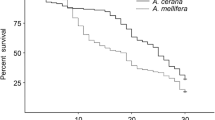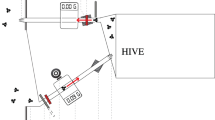Abstract
This study aims to explore the effect of ambient temperature on foraging the activity of Apis cerana and Apis mellifera colonies. We recorded ambient temperature, the time at which foraging commenced, worker thoracic temperature, and brood nest temperature at the same apiary in Kunming, China. We found that A. cerana start foraging earlier and at lower temperatures than do A. mellifera. A. cerana foraging (departures per minute) also peaked earlier and at lower temperature than did A. mellifera foraging. At the same ambient temperature, departing A. mellifera foragers and workers sampled from the brood nest had a higher thoracic temperature than departing A. cerana foragers and brood nest workers. A. mellifera colonies also maintained their brood nest temperature significantly higher than did A. cerana. Our results suggest that the larger A. mellifera foragers require a higher thoracic temperature to be able to forage.

Similar content being viewed by others
References
Bartholomew G.A., B. Heinrich (1981) A matter of size: an examination of endothermy in insects and terrestrial vertebrates, In: Heinrich B. (Ed.), Insect thermoregulation, pp. 46–78. Wiley, New York,
Bishop J.A., W.S. Armbruster (1999) Thermoregulatory abilities of Alaskan bees: effects of size, phylogeny and ecology. Funct. Ecol. 13, 711–724
Bujok B., M. Kleinhenz, S. Fuchs, J. Tautz (2002) Hot spots in the bee hive. Naturwissenschaften 89, 299–301
Coelho J.R. (1991) Thee effect of thorax temperature on force production during tethered flight in honeybee (Apis mellifera) drones, workers, and queens. Physiol. Zool. 64, 823–825
Corbet S.A., M. Fussell, R. Ake, A. Fraser, C. Gunson, A. Savage, K. Smith (1993) Temperature and the pollinating activity of social bees, Ecol. Entomol. 18, 17–30
Dudley R. (2000) The biomechanics of insect flight, Priceton University Press, Princeton NJ.
Dyer F.C., T.D. Seeley (1987) Interspecific comparisons of endothermy in honeybees (Apis): deviations from the expected size-related patterns. J. Exp. Biol. 127, 1–26
Dyer F.C., T.D. Seeley (1991) Nesting behavior and the evolution of worker tempo in four honey bee species. Ecology. 72, 156–170
Dyer A.G., H.M. Whitney, S.E.J. Arnold, B.J. Glover, L. Chittka (2006) Bees associate warmth with floral colour. Nature. 442, 525
Goulson D. (2003) Effects of introduced bees on native ecosytems. Annu. Rev. Ecol. Syst. 34, 1–26
Harrison J.F., J.H. Fewell (2002) Environmental and genetic influences on flight metabolic rate in the honey bee, Apis mellifera. Comp. Biochem. Physiol. A-Mol. Integr. Physiol. 133, 323–333
Heinrich B. (1979) Thermoregulation of African and European honeybees during foraging, attack, and hive exits and returns. J. Exp. Biol. 80, 217–229
Heinrich B. (1993) The hot-blooded insects, Harvard University Press, Cambridge MA
Ji R., B. Xie, G. Yang, D. Li (2003) From introduced species to invasive species—a case study on the Italian bee Apis mellifera L. J. Chin. Ecol. 5, 70–73
Johnson R.A., D.W. Wichern (2002) Applied multivariate statistical analysis, Prentice Hall, Upper Saddle River NJ
Jones J.C., B.P. Oldroyd (2007) Nest thermoregulation in social insects, Adv. Ins. Physiol. 33, 153–191
Jones J., M. Myerscough, S. Graham, B.P. Oldroyd (2004) Honey bee nest thermoregulation: diversity promotes stability, Science 305, 402–404
Jones J., P. Helliwell, M. Beekman, R.J. Maleszka, B.P. Oldroyd (2005) The effects of rearing temperature on developmental stability and learning and memory in the honey bee, Apis mellifera, J. Comp. Physiol. A. 191, 1121–1129
Kevan P.G. (1975) Sun-tracking solar furnaces in high arctic flowers: significance for pollination and insects, Science 189, 723–726
Kleinhenz M., B. Bujok, S. Fuchs, J. Tautz (2003) Hot bees in empty broodnest cells: heating from within, J. Exp. Biol. 206, 4217–4231
Norgate M., S. Boyd-Gerny, V. Simonov, M.G.P. Rosa, T.A. Heard, A.G. Dyer (2010) Ambient temperature influences Australian native stingless bee (Trigona carbonaria) preference for warm nectar, PLoS ONE 5(8), doi:10.1371/journal.pone.0012000
Oldroyd B.P., S. Wongsiri (2006) Asian honey bees. Biology, conservation and human interactions, Harvard University Press, Cambridge, MA.
Oldroyd B.P., T.E. Rinderer, S. Wongsiri (1992) Pollen resource partitioning by Apis dorsata, A. cerana, A andreniformis and A. florea in Thailand. J. Apic. Res. 31, 3–7
Ruttner F. (1988) Biogeography and taxonomy of honeybees, Springer-Verlag, Berlin.
Yang G.-H. (2005) Harm of introducing the western honeybee Apis mellifera L. to the Chinese honeybee Apis cerana F. and its ecological impact. Acta Entomol. Sin. 48, 401–406
Acknowledgments
Financial support was granted by Key Laboratory of Tropical Forest Ecology, Xishuangbanna Tropical Botanical Garden, Chinese Academy of Sciences and Yunnan Agricultural University of China.
Author information
Authors and Affiliations
Corresponding author
Additional information
Manuscript editor: James Nieh
Différences de température, pour le butinage et dans le nid à couvain, entre les abeilles Apis cerana et A. mellifera.
Apis cerana / Apis mellifera / température ambiante / début du butinage / température thoracique
Unterschiede in Sammel- und Brutnesttemperaturen bei den Honigbienenarten Apis cerana und A. mellifera
Apis cerana/Apis mellifera / Sammeltemperatur / Thoraxtemperatur
Rights and permissions
About this article
Cite this article
Tan, K., Yang, S., Wang, ZW. et al. Differences in foraging and broodnest temperature in the honey bees Apis cerana and A. mellifera . Apidologie 43, 618–623 (2012). https://doi.org/10.1007/s13592-012-0136-y
Received:
Revised:
Accepted:
Published:
Issue Date:
DOI: https://doi.org/10.1007/s13592-012-0136-y




